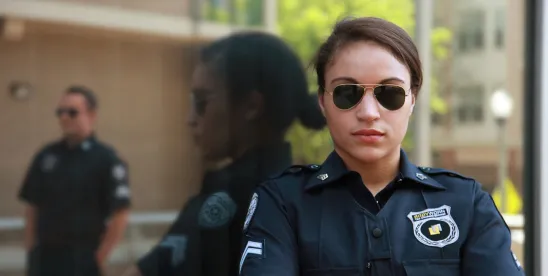The death of Daunte Wright was undeniably a tragedy. And anger about the gross police error that led to his death is understandable and justifiable.
But while the decision to charge the police officer who shot Wright with second-degree manslaughter may have temporarily quieted those clamoring for accountability, the reality is that those charges do not fit.
Under governing legal precedents, the state will have a difficult time making its case.
Background
In order to properly evaluate the propriety of the charges, it’s important to consider some background facts.
In December 2019, Wright allegedly committed an armed robbery, in which he held a woman at gunpoint, choked her and tried to pull cash out from under her bra. Wright was arrested and charged with Aggravated Robbery in the First Degree in connection with that incident and released on $100,000 bail. As a condition of his release, he was barred, among other things, from possessing a firearm. That case was scheduled to proceed to trial this summer.
Thereafter, in June 2020, Wright had another encounter with Minneapolis police, during which he possessed a gun without a permit and fled from the officers. Wright was arrested in connection with that incident. When he failed to show up for a hearing in that case on Apr. 2, a warrant was issued for his arrest.
Most recently, on April 11, Daunte Wright was pulled over by police in Brooklyn Center, Minnesota because his car had an expired registration sticker. When the officers ran Wright’s name through their police database, they learned of his open warrant. Based on that information, the officers directed Wright to exit his car. He complied, and the officers attempted to place him under arrest.
As the officers were trying to handcuff him, Wright struggled with them, broke free and jumped back into his car in an effort to elude capture. Wright’s girlfriend was a passenger in the vehicle.
One of the officers on the scene, Kimberly Potter, drew what she believed to be her stun gun – but which was really her 9 mm Glock service weapon – and shouted “I’ll Tase you, I’ll Tase you!” to Wright. When Wright still failed to yield, Potter yelled “Taser! Taser! Taser!” and fired a single shot at Wright.
The police body camera footage made clear that the officer, Kimberly Potter, had intended to draw her Taser on Wright, but had accidentally drawn her service weapon instead. When she thought she was firing a stun gun at Wright, she instead discharged a bullet.
After being shot, Wright drove off and struck another vehicle about 500 feet away.
Wright was pronounced dead at the scene. The County Medical Examiner determined that Wright died from a gunshot wound to the chest, and ruled his death a homicide.
The Criminal Charges Against Officer Potter
On April 14, three days after Wright’s death, the Washington County Attorney charged Potter with second-degree manslaughter.
Under Minnesota law, a person commits second-degree manslaughter if she causes the death of another by “culpable negligence.” A person engages in “culpable negligence” if she “creates an unreasonable risk, and consciously takes chances of causing death or great bodily harm to another.”
On both of these elements, the prosecution is going to have great difficulty proving Potter’s guilt beyond a reasonable doubt. Indeed, the weakness of the state’s case likely accounts for why, although Potter was charged under a criminal complaint, she still has yet to be indicted.
Unreasonable Risk
Under the governing law regarding police shootings of suspects engaged in vehicular flight, it is improbable that the prosecution would be able to satisfy the first element of second-degree manslaughter – that Potter created an unreasonable risk by drawing her weapon and firing at Wright.
Brosseau v. Haugen
In the 2004 case of Brosseau v. Haugen, the U.S. Supreme Court considered whether a police officer acted unreasonably when she shot a suspect in the back as he attempted to flee from law enforcement authorities in his car.
In that case, police officer Rochelle Brosseau received a complaint that a person named Kenneth Haugen had stolen tools from a shop owned by a man named Glen Tamburello.
The following day, a 911 call came through that Tamburello had confronted Haugen at Haugen’s mother’s house and that the two men were fighting.
Brosseau, who in the meantime had learned that there was an unrelated felony warrant out for Haugen’s arrest on drug and other offenses, responded to the 911 call. When she arrived at the location where the fight was occurring, Haugen fled on foot. Brosseau requested assistance, and two officers arrived with a K-9 to help track Haugen down.
As the police were searching for Haugen, he ran to his Jeep, which was parked in the driveway, jumped in, and closed and locked the door. Tamburello’s pickup was parked in the street, blocking the Jeep in.
Officer Brosseau arrived at the Jeep, pointed her gun at Haugen, and ordered him to get out. Haugen ignored her commands put the keys into the ignition. As the Jeep turned on, Brosseau “jumped back and to the left. She fired one shot through the rear driver’s side window at a forward angle, hitting Haugen in the back.”
Haugen subsequently brought a civil lawsuit alleging that the shot fired by Brosseau constituted excessive force in violation of Haugen’s rights under the Fourth Amendment.
Brosseau moved for summary judgment, claiming that she was entitled to qualified immunity. The District Court agreed with Brosseau and granted summary judgment, but the Ninth Circuit reversed. The U.S. Supreme Court thereafter granted certiorari and reversed in a per curiam decision with no noted dissents.
The Court declined to express a view as to whether Brosseau used an unreasonable degree force, but stated that “where the officer has probable cause to believe that the suspect poses a threat of serious physical harm, either to the officers or to others, it is not constitutionally unreasonable to prevent escape by using deadly force.”
The Court disposed of the case by granting Brosseau qualified immunity – a defense that operates “to protect officers from the sometimes hazy border between excessive and acceptable force.” In the context of Fourth Amendment seizures, officers are entitled to immunity from suit if it was not “clearly established” that their actions were unreasonable.
There, the Supreme Court found that it was “far from … obvious” that Brosseau’s deliberate shooting of Haugen in his back as he was seated in his car on the driveway amounted to an unreasonable use of force. On that basis it dismissed the lawsuit against her.
Plumhoff v. Rickard
A decade after Brosseau, the Supreme Court again considered whether it was reasonable for a police officer to shoot a suspect who was behind the wheel and trying to elude arrest.
In that case, a white Honda Accord being driven by Donald Rickard was pulled over by Lieutenant Joseph Forthman of the West Memphis, Arkansas, Police Department because it had only one operating headlight. When Rickard failed to produce his driver’s license upon request and appeared nervous, Forthman asked him to step out of the car. Rather than comply, Rickard sped away.
Forthman gave chase, and soon was joined by other police cruisers. The officers pursued Rickard’s vehicle into a parking lot. Once in the parking lot, two officers – Sergeant Vance Plumhoff and Officer Jimmy Evans – got out of their police vehicles and approached Rickard’s car. Officer Evans, with his gun in hand, pounded on the passenger-side window.
Rickard pressed the accelerator, but since the Accord’s front bumper was flush against a patrol car, it would not move.
At that point, Sgt. Plumhoff fired three shots into Rickard’s car. Rickard then managed to put the car into reverse and maneuver his car away from the police.
As he drove off, two other police officers fired 12 more shots toward Rickard’s car.
Rickard then lost control of the car and crashed into a building. Rickard and a passenger in his car, Kelly Allen, died from some combination of gunshot wounds and injuries from the crash.
Rickard’s daughter thereafter brought an action against six of the police officers involved in the incident alleging that the officers used excessive force in violation of the Fourth Amendment.
The Supreme Court, in Plumhoff v. Rickard, stated that a police officer’s use of force must be analyzed from the perspective “of a reasonable officer on the scene, rather than with the 20/20 vision of hindsight,” and must take into consideration that police officers “are often forced to make split-second judgments – in circumstances that are tense, uncertain, and rapidly evolving – about the amount of force that is necessary in a particular situation.”
Applying this standard, the Court stated that “under the circumstances at the moment when the shots were fired, all that a reasonable police officer could have concluded was that Rickard was intent on resuming his flight and that, if he was allowed to do so, he would once again pose a deadly threat for others on the road.”
The Court thus concluded that “it is beyond serious dispute that Rickard’s flight posed a grave public safety risk, and … the police acted reasonably in using deadly force to end that risk.”
Mullenix v. Luna
One year after deciding Plumhoff, the Supreme Court considered the case of Mullenix v. Luna – another case that involved a police shooting of a suspect in a vehicle.
There, Sergeant Randy Baker of the Tulia, Texas Police Department followed Israel Leija, Jr., to a drive-in restaurant, with a misdemeanor warrant for his arrest. When Baker approached Leija’s car and informed him that he was under arrest, Leija drove off.
During an 18-minute chase on the interstate, Leija twice called the Tulia Police dispatcher, claiming to have a gun and threatening to shoot at police officers if they did not abandon their pursuit.
As officers maintained their pursuit, Texas Department of Public Safety Trooper Chadrin Mullenix drove to an overpass and, armed with his service rifle, assumed a shooting position. Notably, Mullenix had no training in disabling a vehicle by shooting at it.
As Leija approached the overpass, Mullenix fired six shots – four of which struck Lejia in his upper body, killing him. It turned out that Lejia did not have a gun in the car.
Lejia’s estate filed a lawsuit alleging that Mullenix had violated the Fourth Amendment by using excessive force against Leija. Mullenix moved for summary judgment, but that motion was denied by the District Court.
On appeal, the Fifth Circuit affirmed in a 2-1 decision, with the majority holding that Mullenix’s actions were objectively unreasonable, and therefore constituted an unconstitutional application of excessive force, because, among other things, there were no innocent bystanders and Mullenix’s decision was not a split-second judgment. The Fifth Circuit also affirmed the denial of qualified immunity.
The Supreme Court granted review, but only on the question of whether the lower courts had properly denied qualified immunity to Mullenix, not on whether there was a Fourth Amendment violation.
On the qualified immunity issue, the Court reversed in an eight to one decision, with only Justice Sotomayor dissenting. The Court stated that it has “never found the use of deadly force in connection with a dangerous car chase to violate the Fourth Amendment, let alone to be a basis for denying qualified immunity.”
When Mullenix fired his rifle, said the Court, “he reasonably understood Leija to be a fugitive fleeing arrest, at speeds over 100 miles per hour, who was armed and possibly intoxicated, who had threatened to kill any officer he saw if the police did not abandon their pursuit, and who was racing towards” other officers who were positioned beneath the overpass. Notably, none of these other officers had ever voiced concern about their own safety.
The Court found that “whatever can be said of the wisdom of Mullenix’s choice to shoot at Lejia, this Court’s precedents do not place the conclusion that he acted unreasonably in these circumstances beyond debate.”
The Shooting of Daunte Wright
Media accounts of Wright’s shooting have focused on the fact that Potter accidentally pulled out her gun instead of her Taser during the traffic stop. This error, the argument goes, was the result negligence, and therefore Potter was appropriately charged with involuntary manslaughter – which, broadly defined, is a homicide caused by negligence.
But the actual legal issue here is more nuanced than that. It is not whether Potter was careless in drawing her gun, but whether, under the circumstances, it was reasonable for Potter to have fired that weapon at Wright.
And the Supreme Court cases outlined above suggest that it was.
As Wright was being placed under arrest he wrested himself from the grasp of the police officers and leapt into his car to drive away. By doing so, Wright placed himself in the same category as Kenneth Haugen, Donald Rickard and Israel Leija, Jr. – the suspects in Brosseau, Plumhoff and Mullenix – all of whom were engaged in vehicular flight.
And, like the suspects in Brosseau and Mullenix, Daunte Wright, too, had an open warrant. Importantly, Wright’s warrant was for failing to appear at a hearing in a case for gun possession and for fleeing from the police.
Further, Wright had a separate open gunpoint robbery case and had violated the terms of his bail on that case by possessing a firearm.
Wright also had a passenger in his vehicle and there were other cars on the road in close proximity to where the stop took place – we know this because Wright crashed into one after he sped away from the officers.
Given these factors, it was reasonable for Potter to believe that Wright posed a risk of harm to innocent bystanders, the officers on the scene, and other motorists on the roadway.
Indeed, Plumhoff squarely addresses the situation that confronted Potter – like the suspect in that case, Wright “was intent on resuming his flight and that, if he was allowed to do so, he would ... pose a deadly threat for others on the road.” Since Wright, like the suspect in Plumhoff, “posed a grave public safety risk” – and since the encounter was “tense, uncertain and rapidly evolving” – the use of deadly force by the police to end that risk was reasonable.
That Potter meant to fire her Taser, not her gun, is beside the point, as reasonableness is an objective, not a subjective, standard.
At a minimum, the Supreme Court cases discussed here demonstrate that the shooting of Wright was not obviously unreasonable under the circumstances. Because of that, reasonable doubt exists on the issue of whether Potter “created an unreasonable risk.”
The state, therefore, will not be able to satisfy its burden of proof on the first element of second-degree manslaughter.
Consciously Takes Chance of Causing Death or Great Bodily Harm
Irrespective of the reasonableness of the shooting, the prosecution also will be hard-pressed to prove the second element of the manslaughter charge – that Potter “consciously took a chance of causing death or great bodily harm” to Wright. After all, the video strongly suggests that Potter intended to draw her stun gun, not her firearm.
Perhaps the prosecutors intend to argue that, by using a Taser on Wright, Potter risked killing him or causing him great bodily harm. Implied in this argument, of course, is the premise that Tasers are deadly weapons, or at least ones that cause grave injury.
But courts have rejected this very argument. In Procknow v. Curry, the Eighth Circuit – which encompasses Minnesota – found that Tasers are intended to temporarily incapacitate suspects to prevent harm to officers. And, in Shultz v. Buchanan, the Eighth Circuit held that although a Taser has a “unique capability to cause high levels of pain without long-term injury … we have not categorized the Taser as an implement of force whose use establishes, as a matter of law, more than de minimis injury.”
Further, by Minnesota statute, Tasers are not classified as deadly weapons or ones that cause great bodily harm, but as “electronic incapacitation devices” that are “designed or intended by the manufacturer to be used ... to temporarily immobilize or incapacitate persons.”
Nor does it make sense for the prosecution to argue that Potter deliberately drew her Glock with the intention of shooting Wright – a man she encountered for the first time just minutes prior – in the presence of multiple witnesses and with knowledge that her actions would be captured on video.
The state would have to prove that Potter shouted “Taser! Taser! Taser!” before pulling the trigger – something that the Brooklyn Center Police Manual requires officers to do before deploying a Taser in order to warn nearby officers and give the suspect an opportunity to voluntarily comply – as part of a premeditated plan to make it appear that she erred in drawing her sidearm rather than her stun gun.
To say that such theory strains credulity is an understatement - it is a wild premise that the prosecution could never establish beyond a reasonable doubt.
Conclusion
We can only speculate as to why the Washington County Attorney chose to bring an unwinnable case against Potter – indeed, one month after the incident, Potter still has not been indicted. Perhaps it had something to do with trying to calm a highly volatile situation.
What we do know, however, is that the death of Daunte Wright was a tragedy about which many are justifiably upset. But the solution was not to bring an unsustainable criminal case.
When the charge against Potter is eventually dismissed, those who expected more will lose faith in the rule of law. What’s left of their confidence in our justice system will become the second casualty of this sad event.




 />i
/>i

